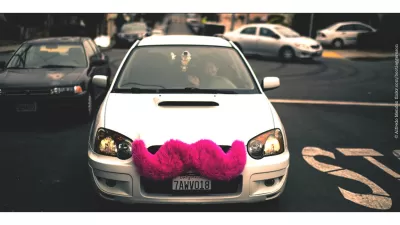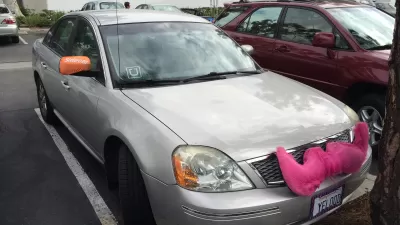In the spirit of civic self-congratulation, Austin resident Richard Parker writes about how the transportation network company giants canceled service after losing a referendum vote. He ascribes this victory to the city's enduring contrarian streak.

Earlier this month in Austin, Texas, voters struck down a measure that would exempt Uber and other transportation network companies from driver fingerprinting. Richard Parker writes that it became "a referendum on who is in the driver's seat (pun intended) when it comes to the public weal: new-economy powerhouses out to 'disrupt' society for fun and profit, or the people they're seeking to disrupt. In Austin, it wasn't even close."
When they lost the vote, Uber and Lyft quit the Texas capital two years after they arrived.
According to Parker, transportation network companies weren't always the public enemy they apparently became. In 2014, with the city full of young creatives, festival-goers, and other Uber-friendly types, transportation network companies seemed like "the perfect fit."
"But what [the companies] failed to appreciate was that Austin's long and storied counterculture wasn't just a marketing pose." Parker writes that many in Austin have resisted the city's transformation into a techie paradise just as hard as they fought Texas' prevailing conservative politics. Some even blamed the companies for worse traffic when drivers developed a habit of stopping mid-street to pick up customers.
He also clarifies that the decision to cut off service wasn't Austin's. "To be clear: The city never told Uber and Lyft to leave. But it did insist that they play by our rules and have drivers be fingerprinted, just like cabbies — particularly after the police investigated at least seven alleged sexual assaults by ride-share drivers in 2015."
FULL STORY: How Austin Beat Uber

Alabama: Trump Terminates Settlements for Black Communities Harmed By Raw Sewage
Trump deemed the landmark civil rights agreement “illegal DEI and environmental justice policy.”

Study: Maui’s Plan to Convert Vacation Rentals to Long-Term Housing Could Cause Nearly $1 Billion Economic Loss
The plan would reduce visitor accommodation by 25% resulting in 1,900 jobs lost.

Why Should We Subsidize Public Transportation?
Many public transit agencies face financial stress due to rising costs, declining fare revenue, and declining subsidies. Transit advocates must provide a strong business case for increasing public transit funding.

Paris Bike Boom Leads to Steep Drop in Air Pollution
The French city’s air quality has improved dramatically in the past 20 years, coinciding with a growth in cycling.

Why Housing Costs More to Build in California Than in Texas
Hard costs like labor and materials combined with ‘soft’ costs such as permitting make building in the San Francisco Bay Area almost three times as costly as in Texas cities.

San Diego County Sees a Rise in Urban Coyotes
San Diego County experiences a rise in urban coyotes, as sightings become prevalent throughout its urban neighbourhoods and surrounding areas.
Urban Design for Planners 1: Software Tools
This six-course series explores essential urban design concepts using open source software and equips planners with the tools they need to participate fully in the urban design process.
Planning for Universal Design
Learn the tools for implementing Universal Design in planning regulations.
Smith Gee Studio
Alamo Area Metropolitan Planning Organization
City of Santa Clarita
Institute for Housing and Urban Development Studies (IHS)
City of Grandview
Harvard GSD Executive Education
Toledo-Lucas County Plan Commissions
Salt Lake City
NYU Wagner Graduate School of Public Service





























